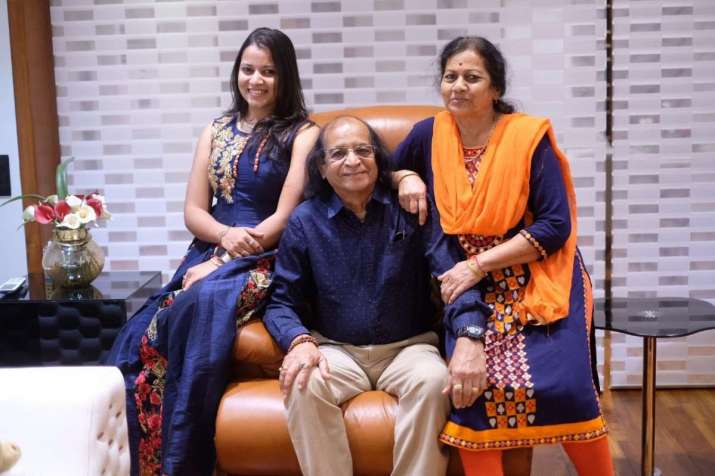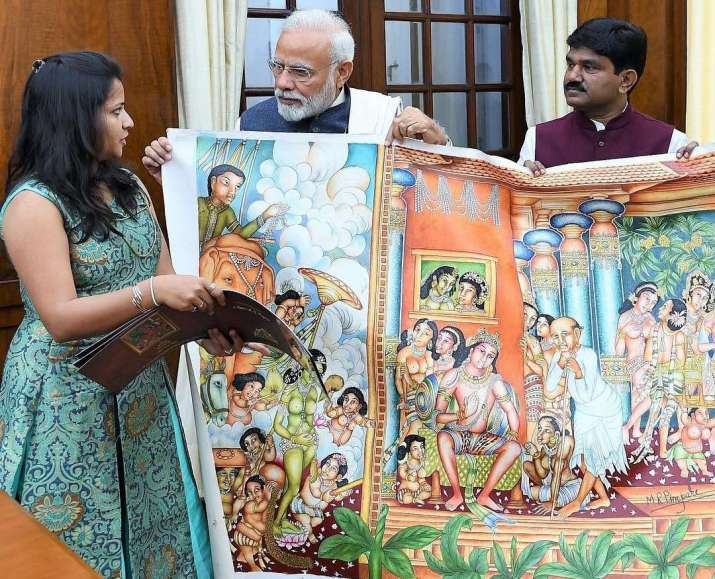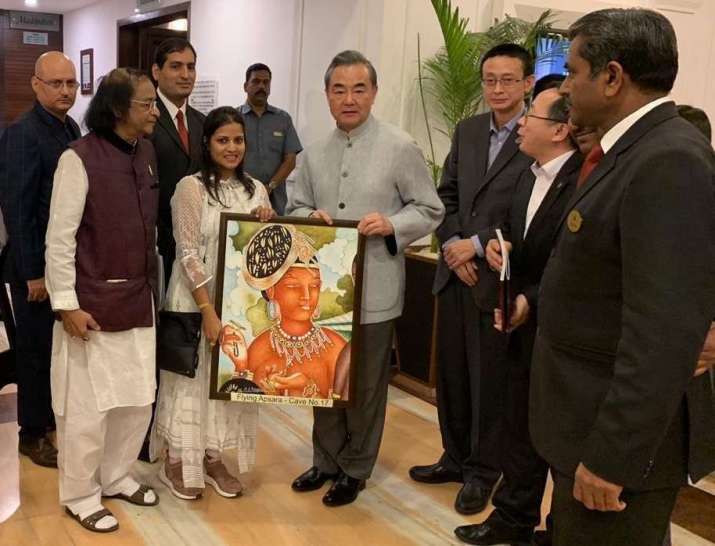
Reliving history is like filling in gaps in deep time: an exercise informed by historical enquiry and sympathetic imagination. Dispeling historical fog is like putting the pieces of a puzzle together, except that this puzzle is a Frankenstein-like beast of archeological ruins, artifacts, decoded languages in epigraphy, or surviving texts hidden in forgotten grottoes. Indian artist M. R. Pimpare has managed to piece together a few pieces of this puzzle in his work on the Ajanta Caves. Pimpare has been researching and reconstructing paintings from the caves since 1965, and his paintings are viewed and celebrated by art historians, writers, archeologists, and statesmen in India and across Asia. In 2012, Pimpare was recognized in the Limca Book of Records (an annual reference book published in India documenting human and natural world records) for having reconstructed some 350 paintings from Ajanta over the past 50 years.
I asked Pimpare whether he knew that he would be devoting his life’s energy to a single albeit important cave site of early Indian Buddhism. “When I visited the Ajanta Caves for first time on a school trip many years ago, most artists of the Archeological Survey of India copied the murals simply as they looked, without attempting to correct or depict the minute details that had been damaged or lost altogether. These experts actually didn’t have much knowledge of anatomy and art. Even at that innocent age, I was saddened to see the condition of the cave paintings and their need for a bolder methodology of restoration,” he explained.

“I thought that someone should try to reconstruct the artwork to make it complete and clearer, so that everyone could more easily visualize the hidden beauty of the paintings as they were first produced,” said Pimpare. “As I grew older, I was becoming more familiar with the caves. Then I got my first job in the archeology department as an artist. Soon I was continuously visiting and studying the caves. I then requested my boss to give me permission to do paintings as he knew my drawing was good. It has been five decades since, and I’m still going.”
The artist firmly believes that his work is of a spiritual nature. “Whenever I am working on some panel of the Jatakas in Ajanta, if I can’t recognize it, I close my eyes and meditate for some time. I am then able to visualize a clear picture of destroyed part of the panel, as if I am watching the complete picture from the second century BCE. Because of this, I was able to complete, figure by figure and panel to panel, a collection of 300 paintings in 50 years. It takes a tremendous amount of time to complete even single figures in full shape and form as I must extract all minute details of the body, ornaments, hairstyles, facial features, and costumes.”
Cave 10, Pimpare said, was the most difficult restoration project of his career: “This is the oldest and most damaged cave in Ajanta. It took me years to complete this task. I struggled finding reliable references and details of this mural. I spent many days in the cave, observing the frieze and trying to connect each figure line by line. The painting has 68 human figures and 53 animals, besides figures of the Buddha and stupas.”

Pimpare’s work is soon to be curated by photographer Kshipra Simon, who will be showing his productions at the Inner Path Festival of Buddhist Art and Philosophy this September in New Delhi. “Mr. Pimpare and I met in 2018, when I was curating an art show for Buddhapurnima with [Indian prime minister] Narendra Modi. During the selection period of works and artists, I was sent Mr. Pimpare’s profile and work for the show by my organisers,” she said. “When I met Mr. Pimpare and his daughter, Mayura, and spoke about his work, I grew fascinated with his dedication to restoring the murals of the Ajanta Caves. I was soon learning more about the caves from Mayura.” Pimpare’s daughter, Mayura, has been an unofficial ambassador of her father’s art, having shown his paintings at meetings with senior Indian political figures and foreign diplomats.
“I did some research and found that while there was a lot of digital restoration by photographers or documentary filmmakers, M. R. Pimpare is really the only artist restoring the murals through his paintings,” said Kshipra. “I wanted to show the world the dedication of an artist to a place where there is no light and who is re-creating artwork that is thousands of years old.”

I asked Kshipra what she finds most striking about Pimpare’s work. “The most beautiful thing about his reconstructed paintings are how we’re able to see ruined components in a fresh and new light,” she related. “Once we see these areas again, we’re able to enjoy every detail, be it light, a reconstructed body part like a hand, a nose, or eye. All the details have been painstakingly taken care of with bold outlines to distinguish between the faded or destroyed shapes of the surviving figures. He pays minute attention to bringing out the differences between the colors that have been chipped away and those that have been preserved. He did a particularly excellent job with the beautiful Vishavantara Jataka and a scene of Buddha preaching in Cave 17.”
Pimpare has no intention of abandoning his lifelong devotion to the Ajanta Caves’ murals. Even when he is inevitably forced to stop, there will hopefully be a new generation of Indian Buddhist art lovers like Mayura and Kshipra taking up the sometimes intimidating calling of art restoration (which involves getting past bureaucratic hurdles and government permissions). I believe there is hope and optimism for the future of this field, especially since at its heart it is fundamentally collaborative—a collective effort between artists, restorers, scholars, and policymakers.
Kshipra put it very well when she concluded: “The conservation and interpretation of Buddhist art is an extension of Buddhist spirituality. Practitioners seek transcendence and a connection to higher realms of existence, which in turn inspires their artwork. In this sense, art becomes an intimate expression of devotion, and the artist a conduit for divine interaction, this can be seen in Mr. Pimpare’s reconstructions of Ajanta’s cave art.”
See more












